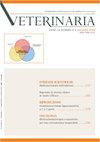AN AGE - CLASS STUDY OF SHEEP ENDOPARASITES IN BISKRA REGION (ALGERIA)
Q4 Veterinary
引用次数: 0
Abstract
The present study aims to evaluate the prevalence of gastrointestinal parasites in sheep of Biskra region according to age classes and to detect eventual zoonotic parasites. It included 372 sheep, females and males. 248 fecal sheep samples were coprologically examined and coprocultured, 119 being from adult sheep (≥ 12 months) and 129 from lambs (< 12 months). Also, 124 adult sheep were necropsied after the slaughter, focusing on the livers, lungs and intestines. The qualitative flotation technique was used by employing the McMaster microscope slides. All the statistics was done by using the SPSS 20. Prevalences were calculated according to age classes and parasites genera. Kendall test (p < 0.05) was applied to detect any correlation between total prevalence and parasite genera prevalences in adults versus lambs. The results showed that medium prevalence for five years in adults (63.02 %) was higher than in lambs (57.36 %). Coproscopy showed: coccidia, gastrointestinal strongyles, Nematodirus spp, Moniezia spp and Marshallagia spp. Coproculture showed Protostrongylus spp. and Dictyocaulus spp. Necropsy revealed Fasciola hepatica, Echinococcus polymorphus, Thysaniezia ovilla, Moniezia expansa, Cysticercus tenuicolis, Cysticercus ovis and Paramphistomum daubenyi. The diversity and simultaneousness of gastrointestinal parasites could have a negative impact on production parameters in infected sheep. The risks of contracting echinococcosis as a major zoonosis requires more respect of deworming programs in dogs and sheep and better vigilance in slaughterhouses.阿尔及利亚比斯克拉地区绵羊体内寄生虫的年龄分级研究
本研究旨在评估比斯克拉地区绵羊胃肠道寄生虫的流行情况,并检测最终的人畜共患寄生虫。它包括372只羊,雌性和雄性。对248份羊粪进行了粪学检查和共培养,其中成年羊(≥12月龄)119份,羔羊(< 12月龄)129份。此外,屠宰后对124只成年羊进行了尸检,重点检查了肝脏、肺部和肠道。采用麦克马斯特显微镜载玻片进行定性浮选。所有数据均采用SPSS 20进行统计。按年龄分类和寄生虫属计算患病率。采用Kendall检验(p < 0.05)检测成人和羔羊的总流行率与寄生虫属流行率之间的相关性。结果表明,5年成人中患病率(63.02%)高于羔羊(57.36%)。粪镜检出球虫、胃肠圆形虫、线虫、蒙氏虫和Marshallagia虫,粪培养检出原圆虫和双鞭毛虫,尸检检出肝片吸虫、多形棘球绦虫、卵囊绦虫、扩张蒙氏绦虫、细囊尾蚴、卵囊尾蚴和大本副吸虫。胃肠道寄生虫的多样性和同时性可能对感染绵羊的生产参数产生负面影响。棘球蚴病作为一种主要的人畜共患疾病,感染该病的风险需要对狗和羊的驱虫计划给予更多的尊重,并在屠宰场提高警惕。
本文章由计算机程序翻译,如有差异,请以英文原文为准。
求助全文
约1分钟内获得全文
求助全文
来源期刊

Veterinaria
农林科学-兽医学
CiteScore
0.10
自引率
0.00%
发文量
21
审稿时长
>12 weeks
期刊介绍:
VETERINARIA is the official scientific journal of the Italian Companion Animal Veterinary Association (SCIVAC) and is published bimonthly by Edizioni Veterinarie (E.V.). Its aim is to promote the spread and development of new ideas and techniques in the field of clinical and veterinary practices, with the ultimate goal of improving and promoting the continuing education of veterinary practicioners. VETERINARIA publishes literature reviews, original articles, diagnostic corners and clinical cases on different topics related to medicine and surgery of the dog, cat and of other companion animals, as well as short communications from congresses.
 求助内容:
求助内容: 应助结果提醒方式:
应助结果提醒方式:


